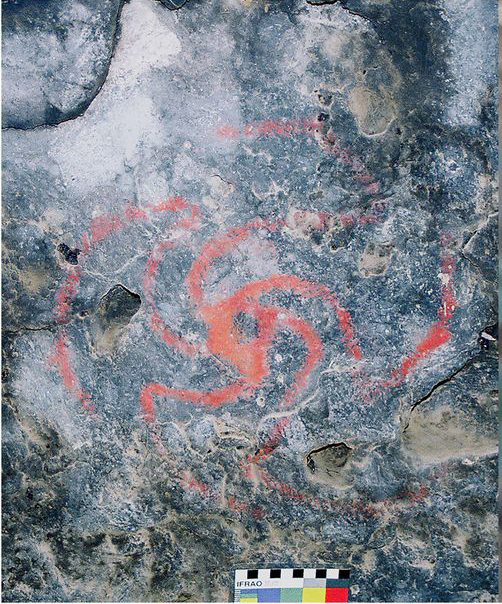Anthropology
Related: About this forumEvidence Links Hallucinogen Use and California Rock Art
Tuesday, November 24, 2020

Tuesday, November 24, 2020
California Rock Art(Photo: Rick Bury)
PRESTON, ENGLAND—According to a Live Science report, researchers led by David Robinson of the University of Central Lancashire have found evidence that the Chumash people ingested hallucinogens at a rock art site in California some 400 years ago. Known as Pinwheel Cave, the rock art features an image of a pinwheel and a moth drawn with ochre. Examination of quids recovered from the cave ceiling with 3-D digital microscopy revealed that the lumps of matted plant fibers had indentations likely to have been made by chewing. Chemical analysis showed that the quids contained the hallucinogenic compounds atropine and scopolamine, which are produced by Datura, a plant also known as jimsonweed and angel trumpet. The pinwheel-shaped flower is twisted up during the day, but it unfurls at dusk and dawn for visiting insects such as the hawk moth, which is known for “loopy” flight after ingesting Datura nectar. The scientists then viewed the quids through a scanning electron microscope, and identified all of the quids but one as Datura flowers. The rock art, Robinson explained, probably “set the scene” for the shared tradition of taking the hallucinogen in the cave. Read the original scholarly article about this research in Proceedings of the National Academy of Sciences. To read about a 1,000-year-old bundle unearthed in Bolivia that contained psychotropic substances, go to "Half in the Bag."
https://www.archaeology.org/news/9236-201124-pinwheel-cave-datura
fearnobush
(3,960 posts)I’m thinking tripping out with Jerry and boys somewhere in San Francisco on a back porch in July.
safeinOhio
(36,802 posts)Classic coffee table book.
Judi Lynn
(164,038 posts)By Laura Geggel - Associate Editor a day ago
When ingested, the flower Datura can induce trances.

A digitally enhanced image of the Indigenous pinwheel drawing that researchers made with a technique called D-Stretch.
(Image: © Devlin Gandy)
Just before going into a hallucinogenic trance, Indigenous Californians who had gathered in a cave likely looked up toward the rocky ceiling, where a pinwheel and big-eyed moth were painted in red.
This mysterious "pinwheel," is likely a depiction of the delicate, white flower of Datura wrightii, a powerful hallucinogen that the Chumash people took not only for ceremonial purposes but also for medicinal and supernatural ones, according to a new study. The moth is likely a species of hawk moth, known for its "loopy" intoxicated flight after slurping up Datura's nectar, the researchers said.
Chewed globs that humans stuck to the cave's ceiling provided more evidence of these ancient trips; these up to 400-year-old lumps, known as quids, contained the mind-altering drugs scopolamine and atropine, which are found in Datura, the researchers said.
. . .
Indigenous people around the world, including ancient cultures in Siberia, North America and South America, are known to have taken mind-altering substances, said Patrick McGovern, the scientific director of the Biomolecular Archaeology Project at the Penn Museum in Philadelphia, who was not involved in the study. And this study used cutting-edge techniques "to elucidate an important biocultural issue — the use of hallucinogens by peoples of the Americas," McGovern told Live Science in an email.
More:
https://www.livescience.com/rock-art-hallucinogen-california.html
Judi Lynn
(164,038 posts)George Dvorsky
Tuesday 12:40PM
•
There’s a cave in California, roughly an hour’s drive from Santa Barbara, whose ceiling features a prominent pinwheel-like drawing. Fascinating new research suggests this painting is not some drug-induced abstraction, but a literal representation of the very thing that makes psychedelic trips possible.
Chewed remnants of the psychedelic plant Datura wrightii offer “unambiguous confirmation of the ingestion of hallucinogens” at Pinwheel Cave in California, according to new research published in Proceedings of the National Academy of Sciences. The rock site was frequented by indigenous Californians roughly 500 years ago. Just as importantly, the dazzling red pinwheel painted onto the low ceiling is a representation of the plant itself, not a depiction of a shaman’s visual experiences while tripping on the drug, the scientists argue. The new paper is consequently challenging the prevailing altered states of consciousness model (ASC), which contends that “hallucinogens have influenced the prehistoric making of images in caves and rock shelters,” as the study authors write.
Indeed, it might be time to retire this seemingly outdated notion. The ASC model suggests abstract images found in cave paintings across the world—things like swirls, zigzags, dots, geometric shapes, and possibly even therianthropes (part-human, part-animal beings)—were inspired by psychedelics. Some experts have even argued that these abstract images are self portraits made by shamans, or depictions of shamans’ experiences while in a trance. That regular folks might partake in these drugs is rarely considered by anthropologists and archaeologists—and in fact, it’s often argued that these cave sites were exclusive to shamans, not a space for the rest of the group.
Trouble is, evidence to support the ASC hypothesis is sorely lacking, as the new paper, led by David W. Robinson from the University of Central Lancashire, points out. Instead, these ambiguous shapes are likely “stock iconographic images drawing upon mythology and the personifying of insects, animals, plant, and astronomical elements such as the sun,” according to the paper.
More:
https://gizmodo.com/is-this-trippy-cave-painting-the-result-of-a-hallucinat-1845747415